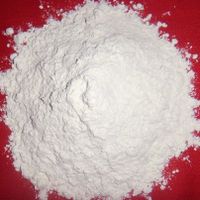Magnesium hydroxide

| |
| Names | |
|---|---|
| IUPAC name
Magnesium hydroxide
| |
| Systematic IUPAC name
magnesium hydroxide | |
| Properties | |
| Appearance | white solid |
| Melting point | 350 °C (662 °F; 623 K) decomposes |
| 0.00064 g/100 mL (25 °C) 0.004 g/100 mL (100 °C) | |
| Except where otherwise noted, data are given for materials in their standard state (at 25 °C [77 °F], 100 kPa). | |
| Infobox references | |
Magnesium hydroxide is inorganic compound with formula Mg(OH)2.It is often known as milk of magnesia, because of its milk-like appearance as a suspension. The solid mineral form of magnesium hydroxide is known as brucite. Suspensions of magnesium hydroxide in water are used as an antacid to neutralize stomach acid, and as a laxative. The diarrhea caused by magnesium hydroxide carries away much of the body's supply of potassium, and failure to take extra potassium may lead to muscle cramps. Magnesium hydroxide is also used as an antiperspirant underarm deodorant.
Contents
Properties
Magnesium hydroxide is an inorganic compound with the chemical formula of hydrated Mg(OH)2. While magnesium hydroxide has a low solubility in water, with a Ksp of 1.5×10−11, it is large enough that it will partially dissolve to produce ions in the solution, forming the suspension. A relatively high concentration of magnesium or hydroxide ions would be required to revert the suspension to the solid precipitate by reversing the equilibrium.
In this suspended form, magnesium hydroxide is a common component of antacids and laxatives; it interferes with the absorption of folic acid and iron. The antacid properties come from the hydroxide ions which are responsible for neutralising the acid.
Preparation
Magnesium hydroxide is composed of magnesium ions and hydroxide ions and it will precipitate whenever the two are present together - ie, combine in a metathesis reaction. The reaction is as follows: Mg2+ (aq) + 2 OH− (aq) → Mg(OH)2 (s) It can be easily prepared by mixing sodium hydroxide (or potassium hydroxide) with Magnesium sulfate. Note that it is extremely hard to filter milk of magnesia: magnesium hydroxide forms a slime-like gel that clogs most filters, and even strong vacuum does not help much.
Availability
From companies like http://magnesiaspecialties.com It's also available in some drugstores as an antacid.
Projects
Handling
Safety
Magnesium hydroxide isn't toxic at all. It's non-flamable and non-explosive.
Storage
In closed bottles.
Disposal
Magnesium hydroxide can be safely thrown out with your normal garbage.